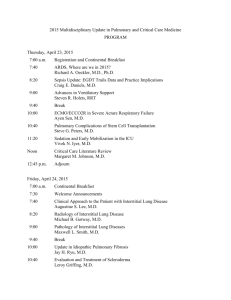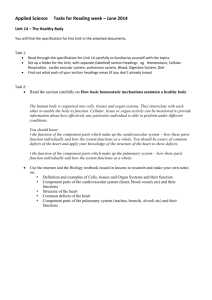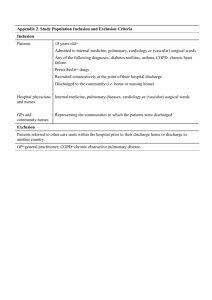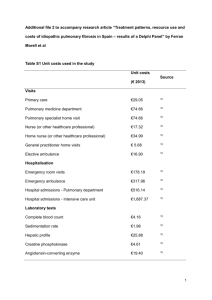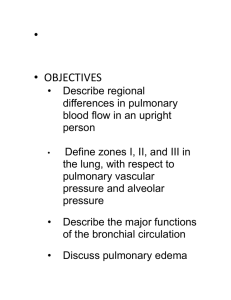phys chapter 38 [12-11
advertisement
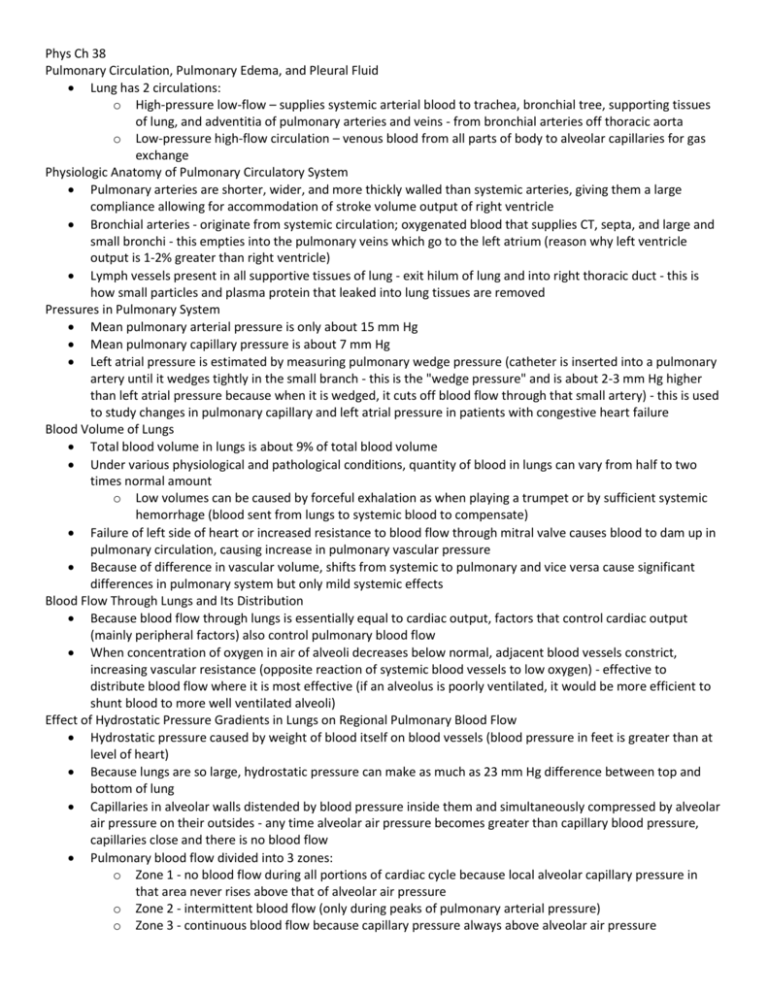
Phys Ch 38 Pulmonary Circulation, Pulmonary Edema, and Pleural Fluid Lung has 2 circulations: o High-pressure low-flow – supplies systemic arterial blood to trachea, bronchial tree, supporting tissues of lung, and adventitia of pulmonary arteries and veins - from bronchial arteries off thoracic aorta o Low-pressure high-flow circulation – venous blood from all parts of body to alveolar capillaries for gas exchange Physiologic Anatomy of Pulmonary Circulatory System Pulmonary arteries are shorter, wider, and more thickly walled than systemic arteries, giving them a large compliance allowing for accommodation of stroke volume output of right ventricle Bronchial arteries - originate from systemic circulation; oxygenated blood that supplies CT, septa, and large and small bronchi - this empties into the pulmonary veins which go to the left atrium (reason why left ventricle output is 1-2% greater than right ventricle) Lymph vessels present in all supportive tissues of lung - exit hilum of lung and into right thoracic duct - this is how small particles and plasma protein that leaked into lung tissues are removed Pressures in Pulmonary System Mean pulmonary arterial pressure is only about 15 mm Hg Mean pulmonary capillary pressure is about 7 mm Hg Left atrial pressure is estimated by measuring pulmonary wedge pressure (catheter is inserted into a pulmonary artery until it wedges tightly in the small branch - this is the "wedge pressure" and is about 2-3 mm Hg higher than left atrial pressure because when it is wedged, it cuts off blood flow through that small artery) - this is used to study changes in pulmonary capillary and left atrial pressure in patients with congestive heart failure Blood Volume of Lungs Total blood volume in lungs is about 9% of total blood volume Under various physiological and pathological conditions, quantity of blood in lungs can vary from half to two times normal amount o Low volumes can be caused by forceful exhalation as when playing a trumpet or by sufficient systemic hemorrhage (blood sent from lungs to systemic blood to compensate) Failure of left side of heart or increased resistance to blood flow through mitral valve causes blood to dam up in pulmonary circulation, causing increase in pulmonary vascular pressure Because of difference in vascular volume, shifts from systemic to pulmonary and vice versa cause significant differences in pulmonary system but only mild systemic effects Blood Flow Through Lungs and Its Distribution Because blood flow through lungs is essentially equal to cardiac output, factors that control cardiac output (mainly peripheral factors) also control pulmonary blood flow When concentration of oxygen in air of alveoli decreases below normal, adjacent blood vessels constrict, increasing vascular resistance (opposite reaction of systemic blood vessels to low oxygen) - effective to distribute blood flow where it is most effective (if an alveolus is poorly ventilated, it would be more efficient to shunt blood to more well ventilated alveoli) Effect of Hydrostatic Pressure Gradients in Lungs on Regional Pulmonary Blood Flow Hydrostatic pressure caused by weight of blood itself on blood vessels (blood pressure in feet is greater than at level of heart) Because lungs are so large, hydrostatic pressure can make as much as 23 mm Hg difference between top and bottom of lung Capillaries in alveolar walls distended by blood pressure inside them and simultaneously compressed by alveolar air pressure on their outsides - any time alveolar air pressure becomes greater than capillary blood pressure, capillaries close and there is no blood flow Pulmonary blood flow divided into 3 zones: o Zone 1 - no blood flow during all portions of cardiac cycle because local alveolar capillary pressure in that area never rises above that of alveolar air pressure o Zone 2 - intermittent blood flow (only during peaks of pulmonary arterial pressure) o Zone 3 - continuous blood flow because capillary pressure always above alveolar air pressure Zones 2 and 3 are normal (zone 2 in apices and zone 3 in lower areas) - if said person is lying down, everything is zone 3 Zone 1 only occurs with too low arterial pressure or too high air pressure (upright person breathing against positive pressure would have zone 1 in apices) Exercise increases blood flow in all parts of lung (apices must be converted to zone 3, so vascular pressure rises) Extra blood flow during exercise comes from increasing number of open capillaries, distending all capillaries and increasing rate of flow through each capillary, and increasing pulmonary arterial pressure (first two are majority in normal person) Ability of lungs to accommodate greatly increased blood flow during exercise without increasing pulmonary arterial pressure conserves energy of right side of heart - prevents significant rise in pulmonary capillary pressure, preventing pulmonary edema Small changes in left atrial pressure during even the most strenuous exercise have virtually no effect on pulmonary circulation because pulmonary venules expand, opening more capillaries so blood continues to flow with almost equal ease from pulmonary arteries When left side of heart fails, blood begins to dam up in left atrium, causing left atrial pressure to rise greatly, causing great increases in pulmonary arterial pressure, causing increased load on right side of heart When left atrial pressure rises above 30mm Hg, it causes similar increases (proportionally higher) in capillary pressure, and pulmonary edema is likely to ensue Pulmonary Capillary Dynamics Alveolar walls lined with so many capillaries that the capillaries almost touch one another side by side in places – thus, capillary blood flows in alveolar walls referred to as “sheet of flow” rather than individual capillaries Pulmonary capillary pressure cannot be directly measured, so it is measured by isogravimetric measurement (mean capillary pressure must lie between mean pulmonary arterial pressure and mean left atrial pressure) Shortening of time through pulmonary capillaries during times of increased cardiac output would be far greater were it not for additional capillaries, which are normally collapsed, opening up to accommodate for increased blood flow Gas exchange in alveolar capillaries occurs in a fraction of a second Dynamics of fluid exchange across lung capillary membranes are qualitatively the same as peripheral tissues, but quantitatively different o Pulmonary capillary pressure is low in comparison with systemic capillaries o Interstitial fluid pressure in lung is slightly more negative than that in peripheral subcutaneous tissue o Pulmonary capillaries relatively leaky to protein molecules, so colloid osmotic pressure of pulmonary interstitial fluid is twice that in peripheral tissues o Alveolar walls are extremely thin, and epithelium is so weak that it can be ruptured by any positive pressure in interstitial spaces greater than alveolar air pressure, which allows dumping of fluid from interstitial spaces into alveoli Normal outward forces (caused by capillary pressure, interstitial fluid colloid osmotic pressure, and negative interstitial fluid pressure) are slightly greater than inward forces (caused by plasma colloid osmotic pressure), providing mean filtration pressure at pulmonary capillary membrane, which causes slight continual flow of fluid from pulmonary capillaries into interstitial spaces o Except for a small amount that evaporates in alveoli, this fluid is pumped back into circulation through pulmonary lymphatic system Because pulmonary capillaries and pulmonary lymphatic system normally maintain slight negative pressure in interstitial spaces, whenever extra fluid appears in alveoli, it will be sucked mechanically into lung interstitium through small openings between alveolar epithelial cells o This excess fluid is either carried away through pulmonary lymphatics or absorbed into pulmonary capillaries, keeping alveoli “dry” except for small amount of fluid that seeps from epithelium onto lining surfaces of alveoli to keep them moist Pulmonary Edema Any factor that increases fluid filtration out of pulmonary capillaries or that impedes pulmonary lymphatic function and causes pulmonary interstitial fluid pressure to rise from negative range into positive range will cause rapid filling of pulmonary interstitial spaces and alveoli with large amounts of free fluid (pulmonary edema) Most common causes of pulmonary edema are o Left-sided heart failure or mitral valve disease – causes great increases in pulmonary venous pressure and pulmonary capillary pressure and flooding of interstitial spaces and alveoli o Damage to pulmonary blood capillary membranes caused by infections such as pneumonia or breathing noxious substances such as chlorine gas or sulfur dioxide gas – causes rapid leakage of plasma proteins and fluid out of capillaries and into both lung interstitial spaces and alveoli Pulmonary capillary pressure must rise to a value at least equal to colloid osmotic pressure of plasma inside capillaries before significant pulmonary edema will occur Once pulmonary edema has begun, fluid accumulation increases even more rapidly with further increases in capillary pressure Acute safety factor – level that pulmonary capillary pressure must rise above normal before pulmonary edema occurs (this is usually about 21 mm Hg – normal level is 7 mm Hg and pulmonary edema doesn’t occur until 28 mm Hg) When pulmonary capillary pressure remains elevated chronically (more than 2 weeks), lungs become even more resistant to pulmonary edema because lymph vessels expand greatly, increasing their capability of carrying fluid away from interstitial spaces o With patients with chronic mitral stenosis, pulmonary capillary pressures twice normal level that would cause pulmonary edema do not cause significant pulmonary edema When pulmonary capillary pressure rises even slightly above safety factor level, lethal pulmonary edema can occur as fast as 20-30 minutes (as would occur in acute left-sided heart failure) Fluid in Pleural Cavity Mucoid fluid allows lungs to slide smoothly with pleural cavity during normal breathing Pleural membrane is porous, mesenchymal, serous membrane through which small amounts of interstitial fluid transude continually into pleural space – these fluids carry tissue proteins with them, giving pleural fluid mucoid characteristic that allows for easy lubrication of moving lungs Total amount of fluid in each pleural cavity is normally only a few mL Whenever quantity becomes more than barely enough to begin flowing in pleural cavity, excess fluid pumped away by lymphatic vessels opening directly from pleural cavity into mediastinum, superior surface of diaphragm, and lateral surfaces of parietal pleura Pleural space called potential space because it is normally so narrow that it is not obviously a physical space Negative force required on outside of lungs to keep lungs expanded – provided by negative pressure in normal pleural space caused by pumping of fluid from space by lymphatics Pleural cavity usually kept a few mm Hg below what the lungs need to prevent collapse – negativity of pleural fluid keeps lungs pulled against parietal pleura of chest cavity Pleural effusion – also called edema of pleural cavity because fluid is analogous to edema fluid o Can be caused by blockage of lymphatic drainage from pleural cavity, cardiac failure (which causes high peripheral and pulmonary capillary pressures, leading to excessive transudation of fluid into pleural cavity), greatly reduced plasma colloid osmotic pressure (allowing excessive transudation of fluid), and infection or any other cause of inflammation of surfaces of pleural cavity (breaks down capillary membranes and allows rapid dumping of both plasma proteins and fluid into cavity)


